Abstract
The influence of several factors on the course of herpes zoster was studied in 151 patients. Dissemination of zoster was associated with the presence of a concurrent disease, especially Hodgkin's disease, and/or the use of immunosuppressive therapy. Several host-immune parameters, including quantitative immunoglobulins, circulating lymphocyte counts, delayed hypersensitivity to multiple skin test antigens, and lymphocyte transformation to phytohemagglutinin did not correlate with dissemination of disease. Development of virus-specific complement-fixing antibody (CFA) was delayed in some patients with disseminated disease.
Vesicle interferon (V-IF) titers were low early in the disease in patients with localized and disseminated zoster and then rose, usually abruptly, to a peak value and declined as pustulation and crusting occurred. However, titers in patients with localized disease rose at an earlier time. This could be seen in terms of time to development of intermediate values of V-IF or by the day on which the sharpest rise occurred. In 15 carefully studied patients with disseminated disease, the development of the maximum V-IF response was followed within 48 hr by cessation of dissemination. Half of the patients in this group had no CFA detectable until after dissemination had ceased.
These findings suggest at least two host factors whose interaction might determine host response to zoster; local interferon production (possibly mediated by sensitized lymphocytes) and humoral antibody, acting to prevent or shorten dissemination of an initially local disease.
Full text
PDF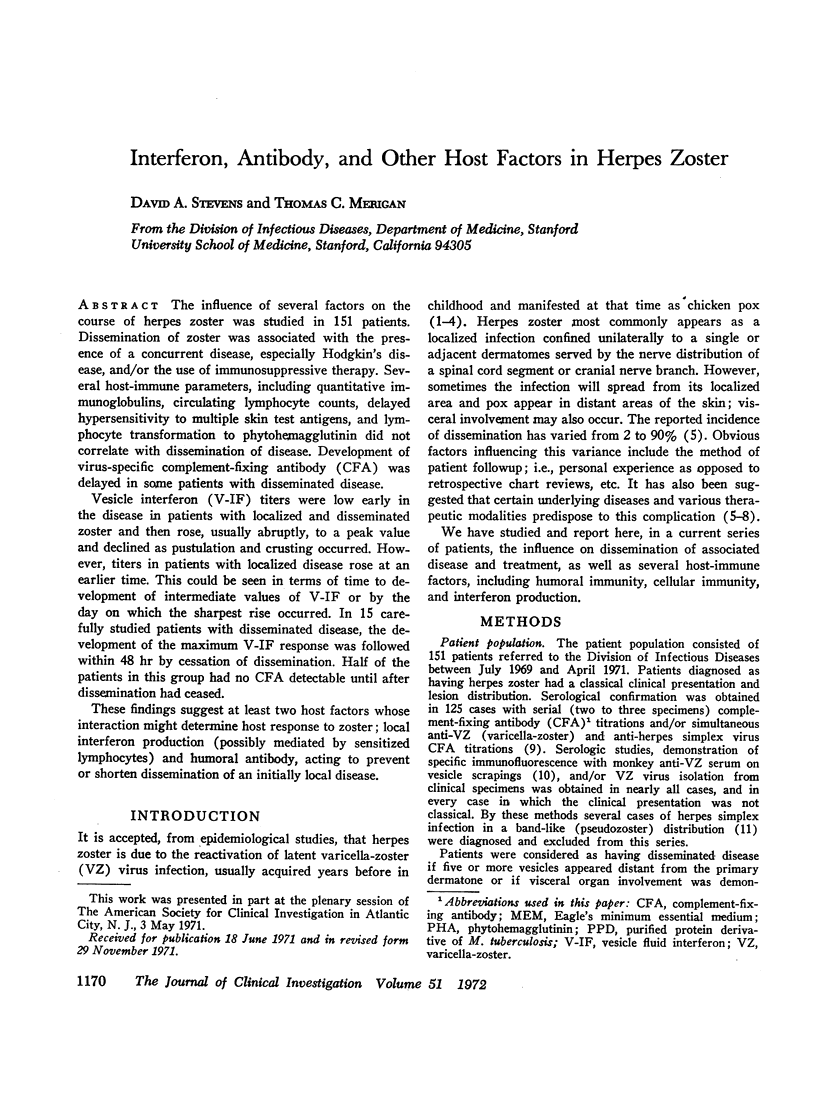
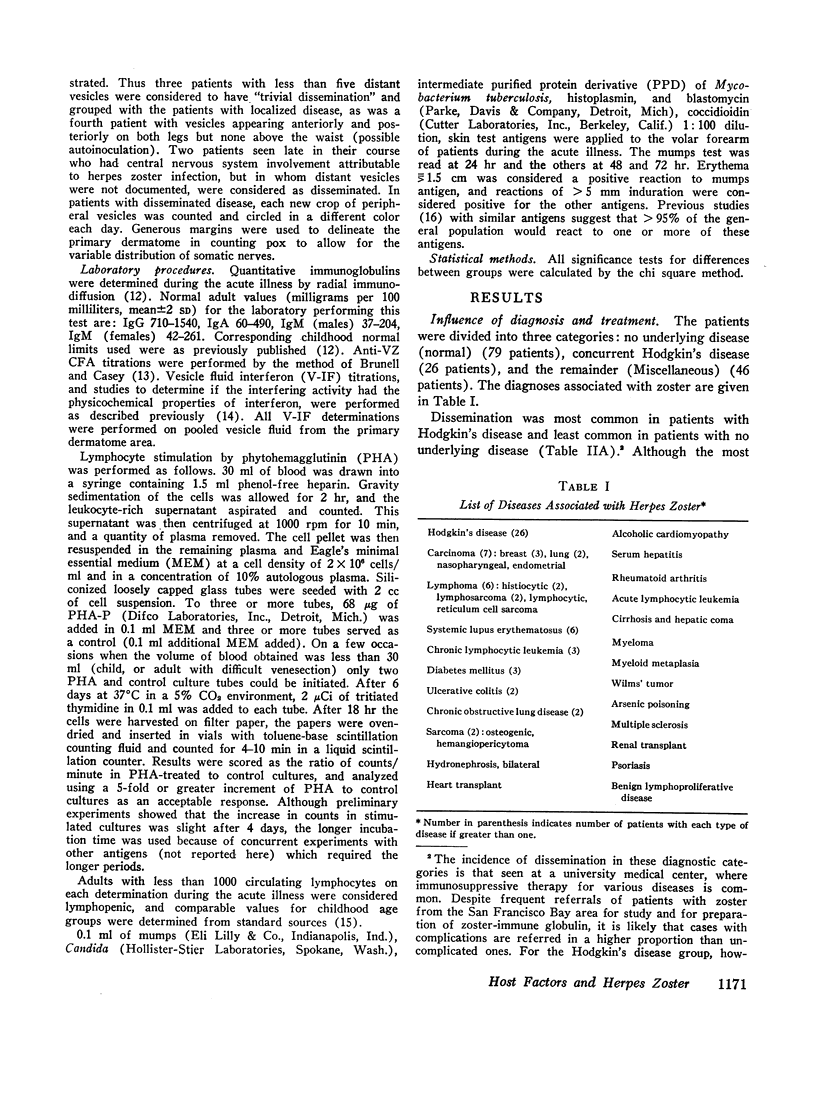
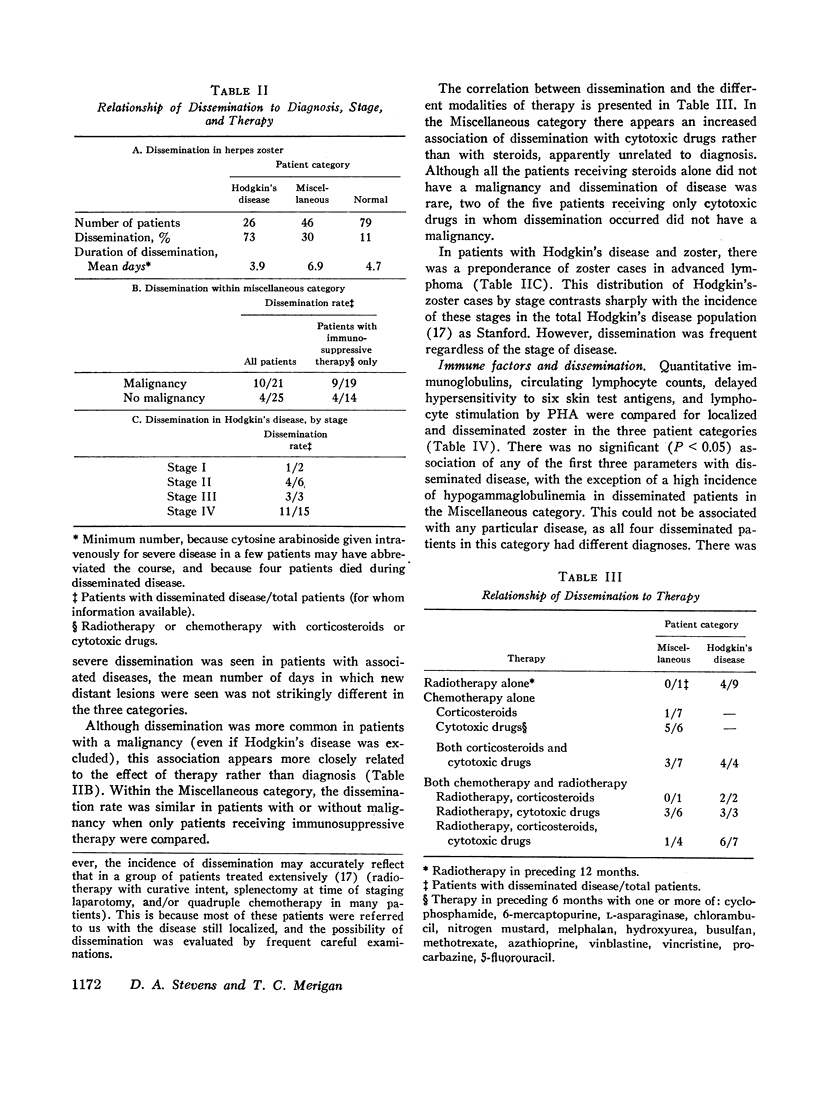
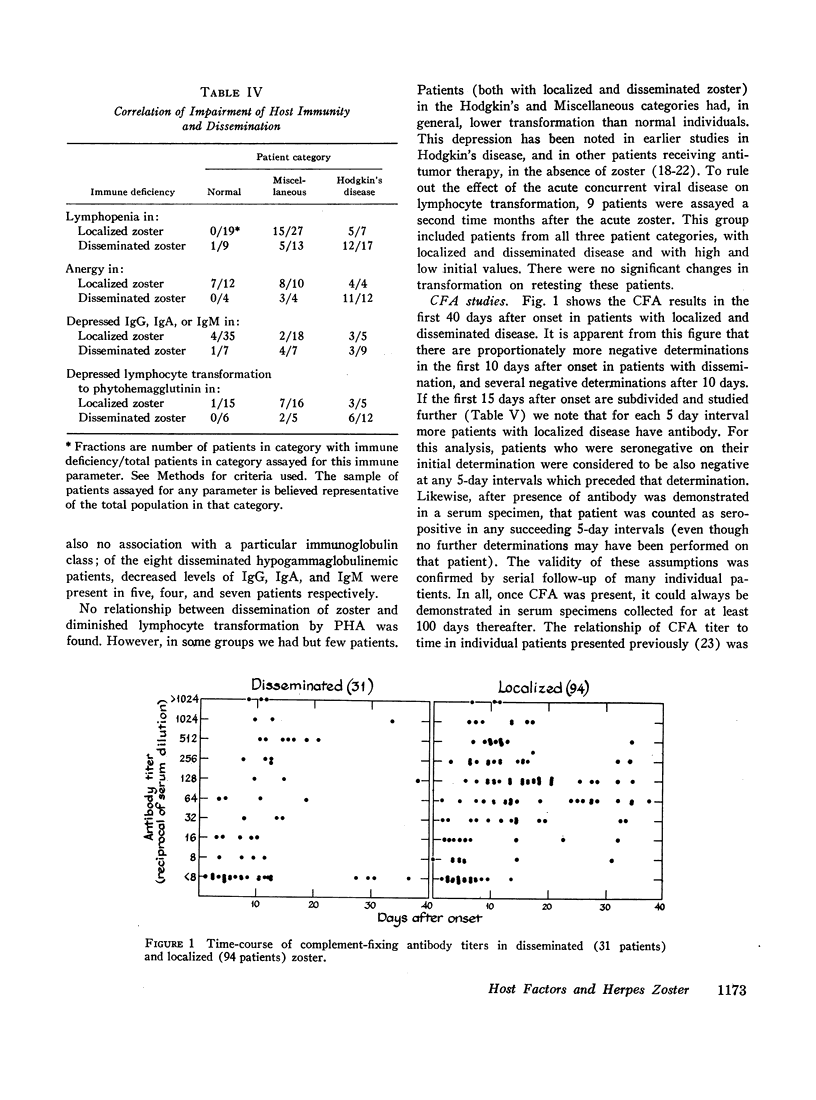
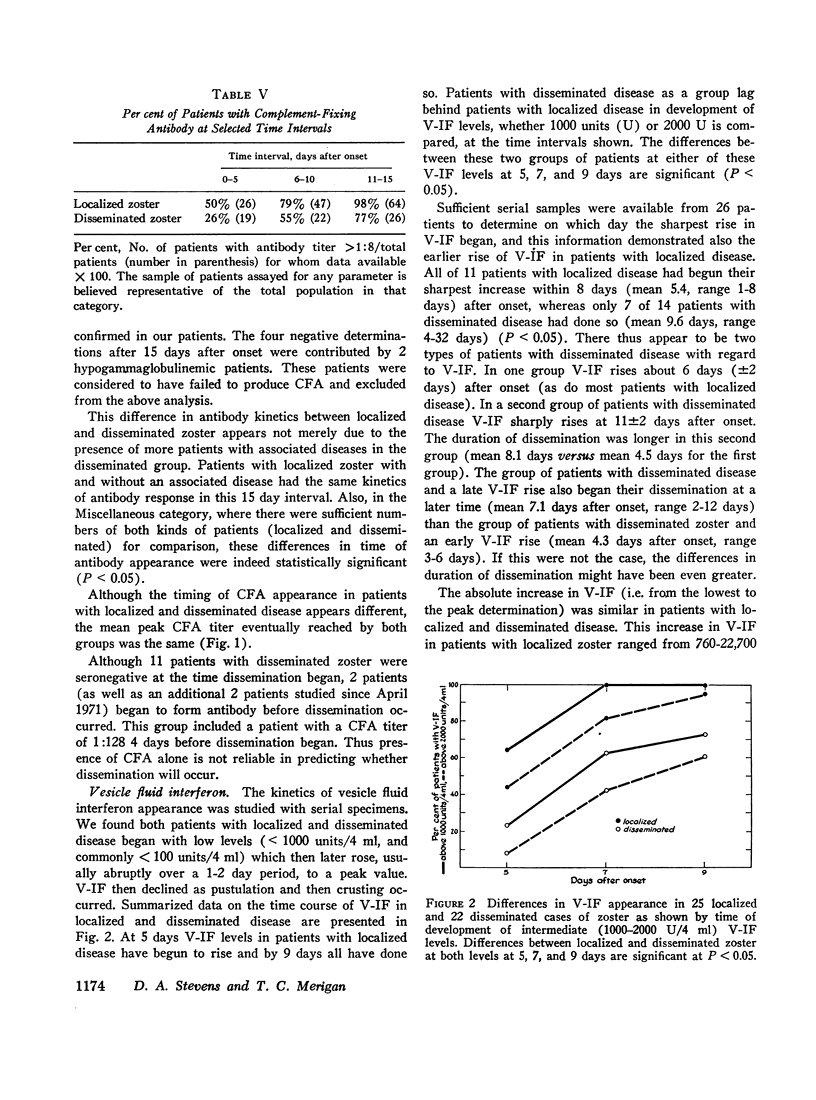
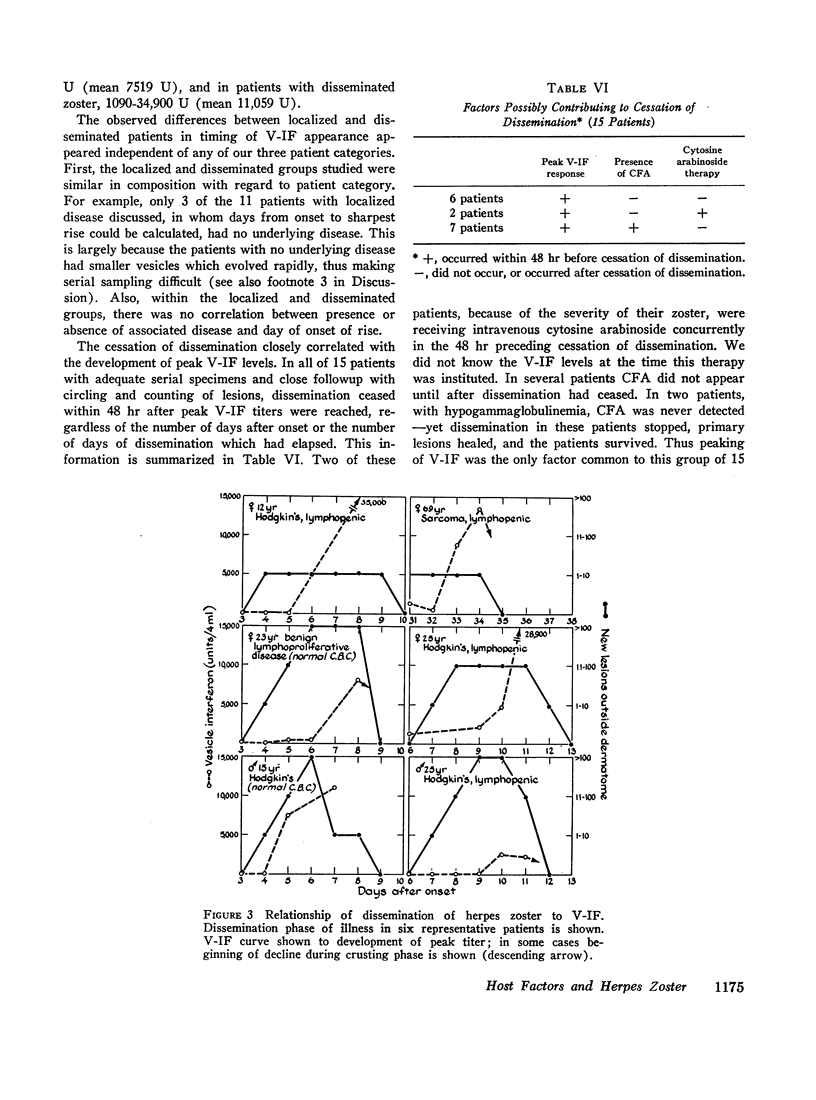
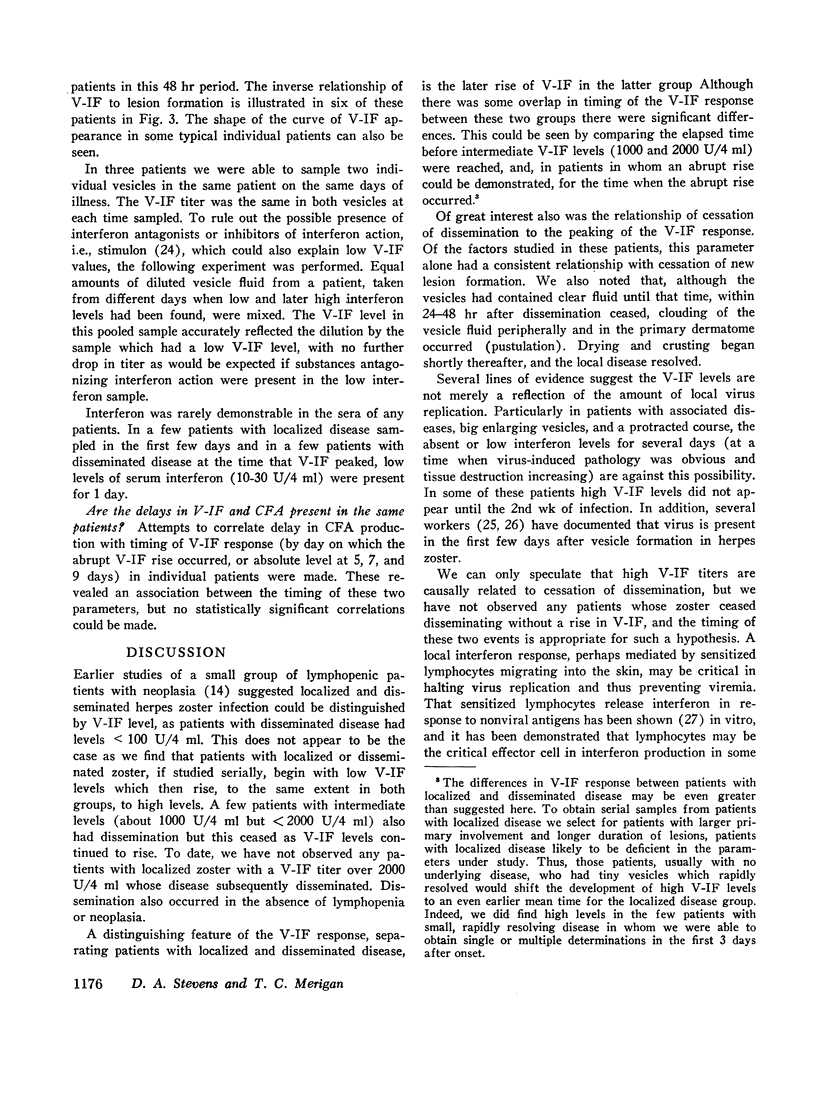
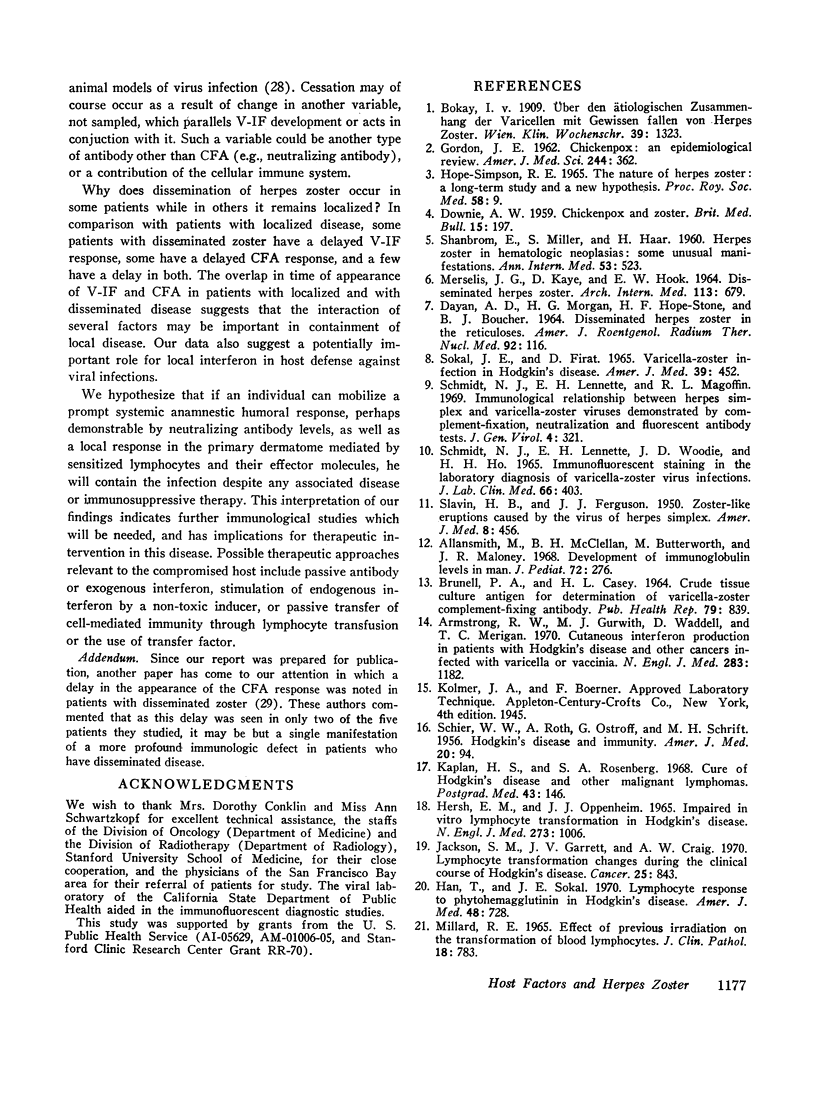
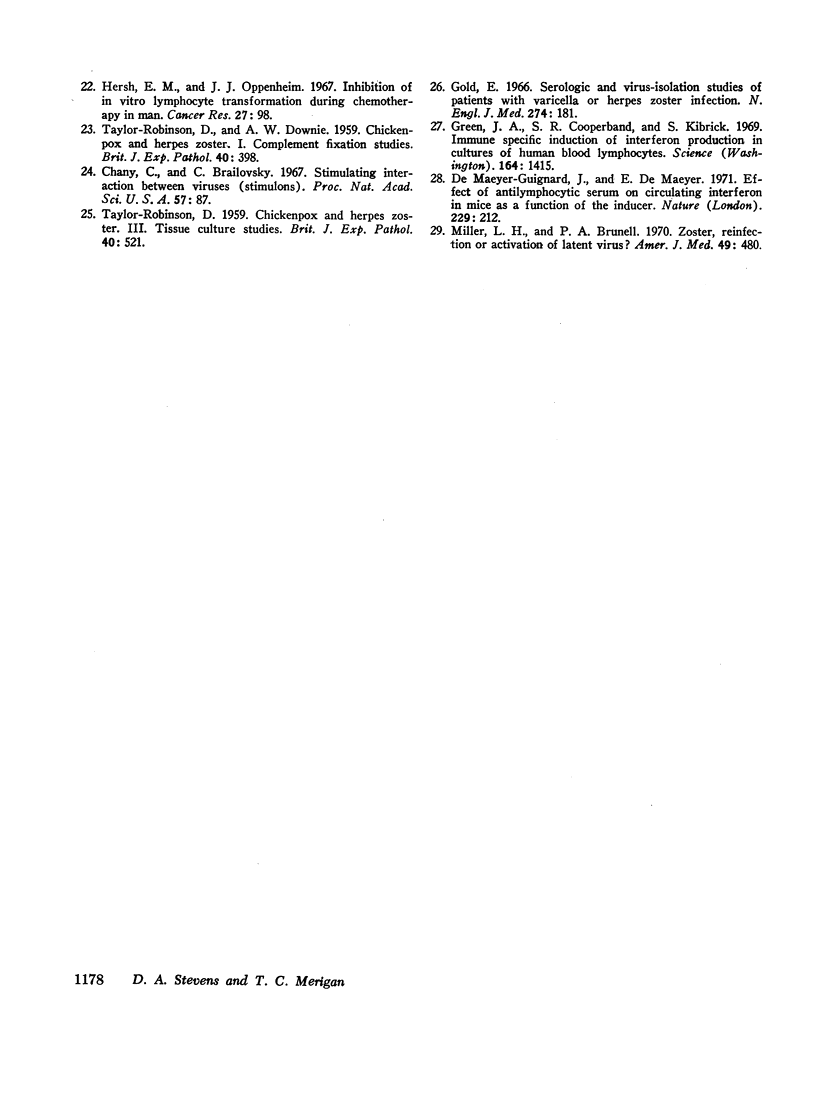
Selected References
These references are in PubMed. This may not be the complete list of references from this article.
- Allansmith M., McClellan B. H., Butterworth M., Maloney J. R. The development of immunoglobulin levels in man. J Pediatr. 1968 Feb;72(2):276–290. doi: 10.1016/s0022-3476(68)80324-5. [DOI] [PubMed] [Google Scholar]
- Armstrong R. W., Gurwith M. J., Waddell D., Merigan T. C. Cutaneous interferon production in patients with Hodgkin's disease and other cancers infected with varicella or vaccinia. N Engl J Med. 1970 Nov 26;283(22):1182–1187. doi: 10.1056/NEJM197011262832202. [DOI] [PubMed] [Google Scholar]
- BRUNELL P. A., CASEY H. L. CRUDE TISSUE CULTURE ANTIGEN FOR DETERMINATION OF VARICELLA-ZOSTER COMPLEMENT FIXING ANTIBODY. Public Health Rep. 1964 Sep;79:839–842. [PMC free article] [PubMed] [Google Scholar]
- Chany C., Brailovsky C. Stimulating interaction between viruses (stimulons). Proc Natl Acad Sci U S A. 1967 Jan;57(1):87–94. doi: 10.1073/pnas.57.1.87. [DOI] [PMC free article] [PubMed] [Google Scholar]
- DAYAN A. D., MORGAN H. G., HOPE-STONE H. F., BOUCHER B. J. DISSEMINATED HERPES ZOSTER IN THE RETICULOSES. Am J Roentgenol Radium Ther Nucl Med. 1964 Jul;92:116–123. [PubMed] [Google Scholar]
- DOWNIE A. W. Chickenpox and zoster. Br Med Bull. 1959 Sep;15:197–200. doi: 10.1093/oxfordjournals.bmb.a069763. [DOI] [PubMed] [Google Scholar]
- GORDON J. E. Chickenpox: an epidemiological review. Am J Med Sci. 1962 Sep;244:362–389. [PubMed] [Google Scholar]
- Gold E. Serologic and virus-isolation studies of patients with varicella or herpes-zoster infection. N Engl J Med. 1966 Jan 27;274(4):181–185. doi: 10.1056/NEJM196601272740403. [DOI] [PubMed] [Google Scholar]
- Green J. A., Cooperband S. R., Kibrick S. Immune specific induction of interferon production in cultures of human blood lymphocytes. Science. 1969 Jun 20;164(3886):1415–1417. doi: 10.1126/science.164.3886.1415. [DOI] [PubMed] [Google Scholar]
- HOPE-SIMPSON R. E. THE NATURE OF HERPES ZOSTER: A LONG-TERM STUDY AND A NEW HYPOTHESIS. Proc R Soc Med. 1965 Jan;58:9–20. [PMC free article] [PubMed] [Google Scholar]
- Han T., Sokal J. E. Lymphocyte response to phytohemagglutinin in Hodgkin's disease. Am J Med. 1970 Jun;48(6):728–734. doi: 10.1016/s0002-9343(70)80008-0. [DOI] [PubMed] [Google Scholar]
- Hersh E. M., Oppenheim J. J. Impaired in vitro lymphocyte transformation in Hodgkin's disease. N Engl J Med. 1965 Nov 4;273(19):1006–1012. doi: 10.1056/NEJM196511042731903. [DOI] [PubMed] [Google Scholar]
- Hersh E. M., Oppenheim J. J. Inhibition of in vitro lymphocyte transformation during chemotherapy in man. Cancer Res. 1967 Jan;27(1):98–105. [PubMed] [Google Scholar]
- Jackson S. M., Garrett J. V., Craig A. W. Lymphocyte transformation changes during the clinical course of Hodgkin's disease. Cancer. 1970 Apr;25(4):843–850. doi: 10.1002/1097-0142(197004)25:4<843::aid-cncr2820250413>3.0.co;2-1. [DOI] [PubMed] [Google Scholar]
- Kaplan H. S., Rosenberg S. A. Cure of Hodgkin's disease and other malignant lymphomas. Postgrad Med. 1968 May;43(5):146–153. doi: 10.1080/00325481.1968.11693253. [DOI] [PubMed] [Google Scholar]
- MERSELIS J. G., Jr, KAYE D., HOOK E. W. DISSEMINATED HERPES ZOSTER. A REPORT OF 17 CASES. Arch Intern Med. 1964 May;113:679–686. doi: 10.1001/archinte.1964.00280110059012. [DOI] [PubMed] [Google Scholar]
- Millard R. E. Effect of previous irradiation on the transformation of blood lymphocytes. J Clin Pathol. 1965 Nov;18(6):783–785. doi: 10.1136/jcp.18.6.783. [DOI] [PMC free article] [PubMed] [Google Scholar]
- Miller L. H., Brunell P. A. Zoster, reinfection or activation of latent virus? Observations on the antibody response. Am J Med. 1970 Oct;49(4):480–483. doi: 10.1016/s0002-9343(70)80042-0. [DOI] [PubMed] [Google Scholar]
- SCHIER W. W., ROTH A., OSTROFF G., SCHRIFT M. H. Hodgkin's disease and immunity. Am J Med. 1956 Jan;20(1):94–99. doi: 10.1016/0002-9343(56)90176-0. [DOI] [PubMed] [Google Scholar]
- SHANBROM E., MILLER S., HAAR H. Herpes zoster in hematologic neoplasias: some unusual manifestations. Ann Intern Med. 1960 Sep;53:523–533. doi: 10.7326/0003-4819-53-3-523. [DOI] [PubMed] [Google Scholar]
- SLAVIN H. B., FERGUSON J. J., Jr Zoster-like eruptions caused by the virus of herpes simplex. Am J Med. 1950 Apr;8(4):456–467. doi: 10.1016/0002-9343(50)90227-0. [DOI] [PubMed] [Google Scholar]
- SOKAL J. E., FIRAT D. VARICELLA-ZOSTER INFECTION IN HODGKIN'S DISEASE: CLINICAL AND EPIDEMIOLOGICAL ASPECTS. Am J Med. 1965 Sep;39:452–463. doi: 10.1016/0002-9343(65)90212-3. [DOI] [PubMed] [Google Scholar]
- Schmidt N. J., Lennette E. H., Magoffin R. L. Immunological relationship between herpes simplex and varicella-zoster viruses demonstrated by complement-fixation, neutralization and fluorescent antibody tests. J Gen Virol. 1969 Apr;4(3):321–328. doi: 10.1099/0022-1317-4-3-321. [DOI] [PubMed] [Google Scholar]
- Schmidt N. J., Lennette E. H., Woodie J. D., Ho H. H. Immunofluorescent staining in the laboratory diagnosis of varicella-zoster virus infections. J Lab Clin Med. 1965 Sep;66(3):403–412. [PubMed] [Google Scholar]
- TAYLOR-ROBINSON D. Chickenpox and herpes zoster. III. Tissue culture studies. Br J Exp Pathol. 1959 Dec;40:521–532. [PMC free article] [PubMed] [Google Scholar]
- TAYLOR-ROBINSON D., DOWNIE A. W. Chickenpox and herpes zoster. 1. Complement fixation studies. Br J Exp Pathol. 1959 Aug;40:398–409. [PMC free article] [PubMed] [Google Scholar]
- de Maeyer-Guignard J., de Maeyer E. Effect of antilymphocytic serum on circulating interferon in mice as a function of the inducer. Nat New Biol. 1971 Feb 17;229(7):212–214. doi: 10.1038/newbio229212a0. [DOI] [PubMed] [Google Scholar]


